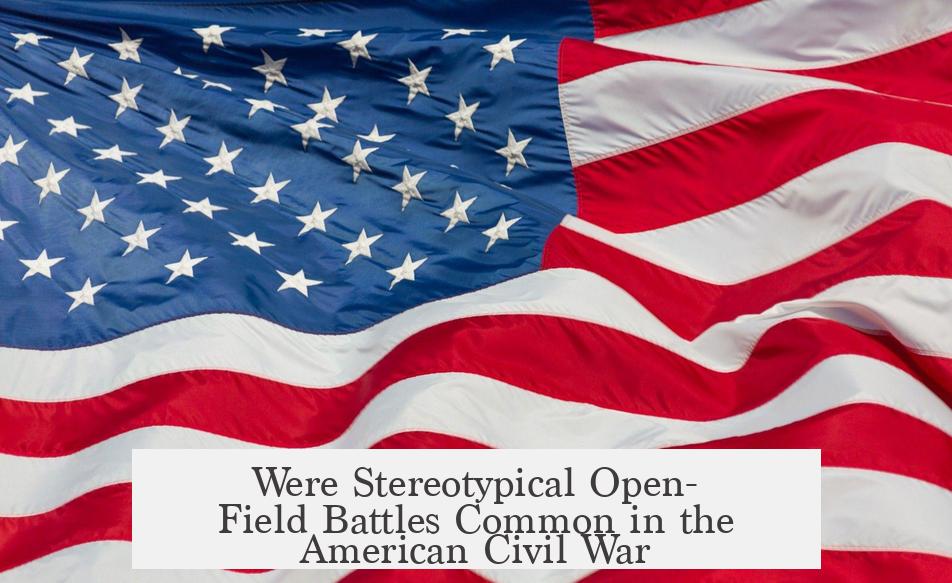Stereotypical open-field battles were not common in the American Civil War. Most clashes did not take place on vast open plains or gentle hills free of obstacles. Large armies rarely met on truly open terrain that could accommodate tens of thousands of troops without natural or man-made cover. This rarity extends beyond the Civil War to broader military history as well.
Battlefields during the Civil War were complex. They often included multiple simultaneous smaller engagements scattered across varied landscapes. These mini-battles each presented unique terrain challenges such as wooded areas, rocky hills, rivers, fences, or buildings. Commanders had to adapt their tactics accordingly.
For example, the Battle of Antietam in 1862 is better understood as three connected but distinct fights rather than one large open-field battle. Soldiers fought near the Sunken Road, a narrow, confined position often called Bloody Lane; in a cornfield offering limited visibility and cover; and at Burnside’s Bridge over Antietam Creek, which posed natural obstacles. None of these scenes represent the classic open plain battle.
Gettysburg, 1863, included some open-field combat, most famously Pickett’s Charge on the third day. This assault crossed a broad field with only a single snake rail fence and a low stone wall in front of Union lines. Yet Gettysburg’s larger action unfolded in wooded ridges, rocky knolls, and orchards, demonstrating the varied terrain where fighting occurred. The open rifle lines often highlighted in films cover just part of the story.
At Fredericksburg, the bloodiest assaults on Marye’s Heights did involve attacking a mostly open and exposed position. Still, other parts of this battle took place among thick woods and across the Rappahannock River. Soldiers faced more than just flat, clear ground during these engagements.
Commanders preferred to avoid fighting on open fields due to the vulnerability it entailed. Instead, their goals commonly included maneuvering to cut supply lines or forcing opponents to attack from exposed, disadvantageous positions. Large-scale open-field battles like the Battle of Franklin were rare and frequently resulted in severe casualties and defeat.
The reason open-field battles are often associated with the Civil War lies primarily in visual representation. Such scenes are easier to depict dramatically and clearly for audiences. A straight, open plain with uniform lines of soldiers visually communicates the scale and order of battle quicker than chaotic, obstructed terrain does.
Historic artwork from the 19th century, including woodcuts and lithographs, often portrayed battles with more fidelity to their actual complexity and terrain. Modern depictions in books and films, however, tend to simplify or exaggerate open-field combat. Cinematic storytelling favors clear visuals over strict historical accuracy.
For instance, the film Gettysburg accurately shows forested hills and narrow rocky areas during the Battle of Little Round Top. Yet the biggest production scene depicts Pickett’s Charge as a grand open assault. Gods and Generals focuses on Fredericksburg and Chancellorsville battles, highlighting open lines for visual clarity despite the real battles featuring mixed terrain. Cold Mountain portrays the chaotic Battle of the Crater, showing initial clear lines quickly dissolving into disorder.
| Battle | Terrain Characteristics | Notable Details |
|---|---|---|
| Antietam | Sunken road, cornfield, narrow bridge | Multiple small fights, obstacles significant |
| Gettysburg | Wooded hills, orchards, open field for Pickett’s Charge | Mixed terrain, open field rare but iconic |
| Fredericksburg | River crossing, wooded areas, open assaults at heights | Assaults on open field costly and bloody |
In summary, open-field battles rarely defined the American Civil War. Most engagements occurred in complex, obstructed terrain. Commanders aimed to exploit terrain advantages and avoid costly exposed combat. Modern portrayals favor open fields due to their dramatic and visual appeal, not historical frequency.
- Most Civil War battles happened in complex terrain, not open plains.
- Open-field combat was rare and often disastrous.
- Examples like Antietam and Fredericksburg show varied terrain obstacles.
- Popular culture exaggerates open battles for visual clarity.
- Commanders avoided open battlefields when possible.
Were Stereotypical Open-Field Battles Common in the American Civil War?

Simply put: no, stereotypical open-field battles were not common in the American Civil War. While popular media often paints a picture of vast plains dotted with rows of soldiers firing in unison, the reality on the ground was far more complex and varied.
Let’s break down why the notion of sprawling, obstacle-free battlefields is mostly a myth—one that owes much to cinematic flair rather than historical fact.
The Reality of 19th Century Combat Terrain
American Civil War battles rarely unfolded on endless, unobstructed plains. Armies often numbered tens of thousands—20,000, 30,000, or even 50,000 soldiers—but encountering equal-sized forces on a wide-open field large enough to hold all combatants was exceedingly rare. You might imagine two huge armies facing off like chess pieces on a bright green board, but the battlefield was usually far less accommodating.
In reality, terrain was a wild card. Battles happened across a patchwork of woods, rocky hills, creeks, cornfields, orchards, fences—even urban streets. Commanders had to adapt quickly to whatever the landscape threw their way. Battlefield “complexity” wasn’t just a buzzword; it defined how strategies were crafted and executed.
Famous Battles Show Varied Terrain Challenges
Antietam, one of the bloodiest days in American history, comprised essentially three smaller battles across different terrains. Fighting raged along the sunken road (later called Bloody Lane), swept through the cornfield, and crossed the precarious Burnside’s Bridge over a creek. None were purely open fields; obstacles shaped the battles’ flow and casualties.
Gettysburg is often remembered for Pickett’s Charge—the classic, wide-open assault. Yet even that’s not as clear-cut as movie scenes suggest. Pickett’s men advanced across a plain interrupted by a simple snake rail fence and a low stone wall. The rest of Gettysburg unfolded over wooded hills and rocky knolls. That famous open charge was an exception rather than the rule.
Similarly, Fredericksburg is best known for brutal attempts to storm Marye’s Heights—an open slope fiercely defended by entrenched Confederates—but these assaults were part of a larger battle fought mostly across rivers and wooded areas. The open field was often an arena of blood and disaster, not the norm.
Commanders Avoided Open-Field Fights When Possible
Why? Open fields exposed soldiers to deadly fire from entrenched enemies. Military leaders preferred maneuver warfare: trying to get between enemy supply lines or forcing opponents into attacking from vulnerable spots. Open ground battles were usually last resorts and often disastrous when they occurred. The Battle of Franklin, for example, showcased a major open-field catastrophe for the Confederates.
Commanders got creative with terrain, understanding its tactical advantages. The rugged American landscape—with its natural obstacles—acted more like an ally for defense than a barren stage for showy charges.
The Gap Between Historical Reality and Popular Imagination

Now, if wide-open field battles were rare, why do they dominate our mental image of the Civil War?
The answer lies partly in visual communication and entertainment. Wide, clear battle scenes are easier for viewers to understand—clear lines, defined formations, no confusing smoke and underbrush. Historical artists and lithographers of the time portrayed battles with an accuracy that blended terrain and chaos. Contrast that with modern movies, which often simplify or exaggerate for dramatic effect.
Films like Gettysburg focused their biggest budgets on large, open charges like Pickett’s Charge—not just to stay true to history, but because visually they make for thrilling cinema. Forested hills, rocky terrain, or close-quarter skirmishes don’t translate as well on the big screen without confusing viewers.
Gods and Generals and Cold Mountain show variations of this trend—some scenes hint at messy, complex battles, but they still rely heavily on sweeping lines and clear divisions to keep audiences engaged.
The Takeaway: It’s More Nuanced Than You Think
Civil War battles were complex tapestries of terrain, obstacles, and tactical nuance. While open fields did feature sometimes, they rarely represented the battleground’s full reality. The image of vast, orderly lines firing across spacious plains is, at best, an oversimplification influenced by art and film.
Next time you watch a Civil War movie or look at a painting, try picturing the forests, fences, and creeks the soldiers had to navigate. Imagine the sweat and fear of maneuvering in broken terrain or under fire from hidden enemies. That’s closer to the truth.
Got Battle Terrain Questions?
Ever wonder how commanders decided when to charge or dig in? Or how natural features like fences or hills could turn a battle’s tide? Understanding the terrain’s role opens new doors to appreciating Civil War history beyond the cliché open fields. History isn’t just about soldiers and orders—it’s also about the land beneath their boots.
If you’re curious, dig into battle maps or firsthand accounts. You’ll find a world much richer and messier than those neatly posed lines in movies or old prints. That complexity shaped some of the most gripping moments in American history—and made the Civil War a conflict still studied and marveled at centuries later.




